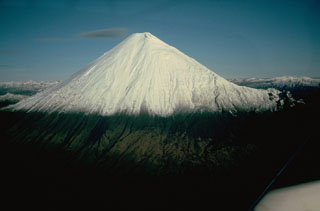Report on Sangay (Ecuador) — 14 April-20 April 2021
Smithsonian Institution / US Geological Survey
Weekly Volcanic Activity Report, 14 April-20 April 2021
Managing Editor: Sally Sennert.
Please cite this report as:
Global Volcanism Program, 2021. Report on Sangay (Ecuador) (Sennert, S, ed.). Weekly Volcanic Activity Report, 14 April-20 April 2021. Smithsonian Institution and US Geological Survey.
Sangay
Ecuador
2.005°S, 78.341°W; summit elev. 5286 m
All times are local (unless otherwise noted)
IG reported a high level of activity at Sangay during 13-20 April. Seismicity was characterized by daily explosions, long-period earthquakes, lahar events, and signals indicating emissions. Weather clouds and rain often prevented visual observations of the volcano, though based on the Washington VAAC and webcam images, ash plumes were visible during 13-14 and 17-20 April rising 600-2,400 m above the summit and drifting mainly N, NW, and W. The seismic network occasionally recorded lahar signals, especially during 14-16 April. Ashfall was reported in Chimborazo (W) and Guamote (40 km WNW) on 17 April, and crater incandescence was visible through the night of 19-20 April.
Geological Summary. The isolated Sangay volcano, located east of the Andean crest, is the southernmost of Ecuador's volcanoes and its most active. The steep-sided, glacier-covered, dominantly andesitic volcano grew within the open calderas of two previous edifices which were destroyed by collapse to the east, producing large debris avalanches that reached the Amazonian lowlands. The modern edifice dates back to at least 14,000 years ago. It towers above the tropical jungle on the east side; on the other sides flat plains of ash have been eroded by heavy rains into steep-walled canyons up to 600 m deep. The earliest report of an eruption was in 1628. Almost continuous eruptions were reported from 1728 until 1916, and again from 1934 to the present. The almost constant activity has caused frequent changes to the morphology of the summit crater complex.
Source: Instituto Geofísico-Escuela Politécnica Nacional (IG-EPN)

